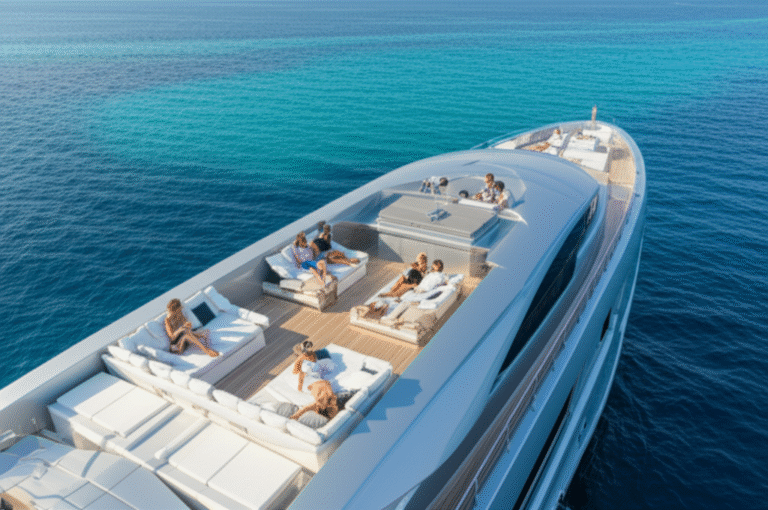Support our educational content for free when you purchase through links on our site. Learn more
12 Legendary Vintage Fiberglass Boat Manufacturers You Must Know 🚤 (2025)

Step back in time with us as we explore the fascinating world of vintage fiberglass boat manufacturers—the pioneers who transformed boating forever. Did you know that the first mass-produced fiberglass boats appeared as early as the 1950s, revolutionizing the industry with lightweight, durable hulls that are still sailing strong today? From the sleek mahogany-trimmed Chris-Craft Corsair to the offshore-ready Bertram 31, these classic vessels aren’t just boats—they’re floating pieces of history, craftsmanship, and passion.
But why are these vintage fiberglass boats still making waves in 2025? What makes them so collectible, and how can you spot an authentic classic? Whether you’re hunting for your dream vintage runabout or curious about restoration tips, we’ve got you covered with insider knowledge, detailed brand profiles, and expert advice. Ready to uncover the legends behind the fiberglass revolution and maybe even find your next timeless treasure? Let’s dive in!
Key Takeaways
- Vintage fiberglass boats emerged in the 1950s, pioneering lightweight, durable hull construction that changed boating forever.
- Top manufacturers like Chris-Craft, Glasspar, Century, and Bertram set the standard for design, performance, and collectability.
- Authenticity matters: Learn how to identify original gelcoat, hardware, and Hull Identification Numbers (HIN) to avoid costly mistakes.
- Restoration is a rewarding journey but requires careful planning, quality materials, and expert advice to preserve value and charm.
- Vintage boats often appreciate in value, making them not only a passion project but a smart investment for collectors.
- Maintenance and community support are key to keeping these classics sailing smoothly for decades to come.
Ready to explore or shop for vintage fiberglass boats and parts? Check out:
- Chris-Craft Boats: Amazon | Chris-Craft Official
- Glasspar Vintage Parts: FiberGlassics® | eBay
- Century Boats: Amazon | Century Official
Dive deeper into the world of vintage boats with our full guide!
Table of Contents
- Quick Tips and Facts About Vintage Fiberglass Boats ⚓
- The Rise of Vintage Fiberglass Boats: A Historical Voyage 🕰️
- Top 12 Legendary Vintage Fiberglass Boat Manufacturers You Need to Know 🚤
- Why Vintage Fiberglass Boats Are Still Making Waves Today 🌊
- How to Identify Authentic Vintage Fiberglass Boats: A Collector’s Guide 🔍
- Restoration Tips for Vintage Fiberglass Boats: Bringing Classics Back to Life 🛠️
- The Most Iconic Vintage Fiberglass Boat Models and Their Stories 📜
- Where to Find Vintage Fiberglass Boats for Sale: Insider Market Secrets 💰
- Maintenance Must-Knows for Vintage Fiberglass Boats: Keep Your Classic Sailing Smoothly ⚙️
- Comparing Vintage Fiberglass Boats to Modern Counterparts: Pros and Cons ⚖️
- Collector’s Corner: How Vintage Fiberglass Boats Appreciate in Value Over Time 💎
- Sailing Into the Future: The Legacy and Influence of Vintage Fiberglass Boat Makers 🌟
- Conclusion: Why Vintage Fiberglass Boats Are Timeless Treasures 🏆
- Recommended Links for Vintage Fiberglass Boat Enthusiasts 🔗
- FAQ: Your Vintage Fiberglass Boat Questions Answered ❓
- Reference Links and Resources for Deep Dives 📚
Quick Tips and Facts About Vintage Fiberglass Boats ⚓
Welcome aboard! Before we dive deep into the fascinating world of vintage fiberglass boat manufacturers, let’s drop anchor with some quick tips and essential facts that every enthusiast should know. Whether you’re a seasoned boater or a curious newbie, these nuggets will keep you sailing smoothly.
Quick Facts at a Glance
| Fact | Detail |
|---|---|
| First Fiberglass Boats | Early 1950s, revolutionized boatbuilding with lightweight, durable hulls |
| Popular Vintage Era | 1950s to late 1970s |
| Common Brands | Chris-Craft, Glasspar, Century, Lancer, and more |
| Typical Hull Types | V-hulls, flat-bottom, and modified V |
| Maintenance Tip | Check for osmosis (blistering) and gelcoat cracks regularly |
| Restoration Popularity | Vintage fiberglass boats are highly collectible and often restored |
| Value Trend | Classic models appreciate in value with originality and condition |
Insider Tips from Boat Brands™ Experts
- Inspect the gelcoat carefully! It’s the first defense against water damage and fading. A dull or blistered gelcoat often signals deeper issues.
- Look for original parts. Authentic hardware and fittings can significantly boost a vintage boat’s value.
- Ask about the boat’s history. Knowing previous owners and maintenance records can save you headaches.
- Beware of cheap restorations. Some “refurbished” boats hide structural problems under fresh paint.
- Join vintage boat clubs and forums. Communities like FiberGlassics® are gold mines for advice and parts.
For a detailed dive on ownership costs, check out our What is the Average Cost of Boat Ownership? 🛥️ (2025) guide.
The Rise of Vintage Fiberglass Boats: A Historical Voyage 🕰️
Fiberglass boats didn’t just appear overnight—they were born from innovation and a splash of daring. Let’s rewind to the mid-20th century and chart the course of how fiberglass revolutionized boating.
The Fiberglass Revolution
Before fiberglass, boats were mostly wooden—beautiful but high-maintenance and prone to rot. Enter fiberglass-reinforced plastic (FRP) in the early 1950s, a game-changer that offered:
- Lightweight yet strong hulls
- Lower maintenance compared to wood
- Mass production possibilities
Pioneers of Fiberglass Boat Manufacturing
- Glasspar Company (Founded 1947): Often credited as the first to mass-produce fiberglass boats, Glasspar’s sleek runabouts set the standard.
- Chris-Craft: Transitioned from wood to fiberglass in the 1950s, blending classic style with new tech.
- Century Boats: Known for performance and style, Century embraced fiberglass early and became a household name.
- Lancer Yachts: Specialized in fiberglass sailboats and powerboats, gaining a loyal following.
Why the 50s-70s Were the Golden Age
- Post-WWII economic boom fueled leisure boating.
- Fiberglass technology matured, enabling diverse designs.
- Manufacturers competed fiercely, leading to innovation and quality.
Fun Fact
The 1959 Glasspar G3 is considered one of the first commercially successful fiberglass boats, and collectors still hunt for these beauties today!
For more on the history and evolution of boat manufacturing, visit our Boat Manufacturers section.
Top 12 Legendary Vintage Fiberglass Boat Manufacturers You Need to Know 🚤
Ready to meet the legends? These manufacturers shaped the vintage fiberglass boat scene and still command respect among collectors and boaters alike.
| Rank | Manufacturer | Specialty | Notable Models | Legacy Highlights |
|---|---|---|---|---|
| 1 | Chris-Craft | Classic runabouts | Corsair, Commander | Iconic American brand, luxury styling |
| 2 | Glasspar | Early fiberglass pioneers | G3, G4 | First mass-produced fiberglass boats |
| 3 | Century Boats | Performance & sport boats | Coronado, Resorter | Sleek designs, racing heritage |
| 4 | Lancer Yachts | Sailboats & powerboats | Lancer 25, Lancer 36 | Innovative fiberglass sail designs |
| 5 | Hatteras Yachts | Offshore powerboats | 32 Convertible, 44 Sportfish | Known for durability and offshore capability |
| 6 | Chris-Craft Commander | Sport cruisers | Commander 22, 28 | Blend of style and function |
| 7 | Bertram Yachts | Sportfishing boats | Bertram 31, 35 | Legendary offshore fishing boats |
| 8 | Glastron | Sport boats | V-174, Carlson | Affordable fiberglass sport boats |
| 9 | Sea Ray | Cruisers & sport boats | Sea Ray 185, 210 | Popular for family boating |
| 10 | Lyman Boats | Runabouts & cruisers | Lyman 23, 25 | Classic New England style |
| 11 | Chris-Craft Cavalier | Mid-size cruisers | Cavalier 25, 27 | Elegant design, quality craftsmanship |
| 12 | Albin Marine | Sailboats & trawlers | Albin Vega, Albin 28 | Scandinavian design, seaworthy |
What Makes These Brands Stand Out?
- Chris-Craft: The Rolls-Royce of vintage boats, known for craftsmanship and timeless beauty.
- Glasspar: The trailblazer that proved fiberglass could outperform wood.
- Century: The speed demon with a racing pedigree.
- Lancer: The innovator in fiberglass sailboats.
- Hatteras & Bertram: The offshore warriors built tough for big water.
User Story
One of our Boat Brands™ team members restored a 1965 Chris-Craft Commander. The boat’s original mahogany accents and classic hull shape made it a showstopper at local boat shows—and a joy to pilot on weekend cruises.
Why Vintage Fiberglass Boats Are Still Making Waves Today 🌊
You might wonder, with all the modern boats out there, why do vintage fiberglass boats keep their charm? Here’s why these classics continue to sail strong.
Timeless Design and Craftsmanship
- Distinctive styling that modern boats often lack.
- Handcrafted details that give each boat personality.
- Solid fiberglass hulls that, when maintained, last decades.
Collectability and Investment
- Vintage fiberglass boats are increasingly rare.
- Well-maintained originals can appreciate in value.
- They offer a nostalgic connection to boating’s golden era.
Community and Culture
- Vintage boat rallies and shows are booming.
- Owners share restoration tips and swap parts in dedicated forums.
- The passion for old boats is “addictive and contagious,” as the FiberGlassics® community puts it.
Environmental Considerations
- Restoring and maintaining vintage boats is a form of sustainable boating.
- Keeps classic craftsmanship alive and reduces waste.
For more on the boating lifestyle, check out our Boat Industry News updates.
How to Identify Authentic Vintage Fiberglass Boats: A Collector’s Guide 🔍
Spotting a genuine vintage fiberglass boat isn’t always straightforward. Here’s a step-by-step guide to help you separate the real deal from the imposters.
Step 1: Check the Hull Identification Number (HIN)
- The HIN is usually on the transom.
- Vintage HINs follow a specific format; cross-reference with manufacturer records.
- Use the U.S. Coast Guard’s HIN guide for verification.
Step 2: Examine the Gelcoat and Fiberglass
- Look for original gelcoat color and texture.
- Be wary of recent repainting that may hide damage.
- Check for blistering or osmosis, common in older fiberglass.
Step 3: Inspect Hardware and Fittings
- Original brass or chrome fittings add authenticity.
- Replacement parts may lower value but can improve functionality.
Step 4: Review Documentation and Provenance
- Maintenance logs, original sales brochures, and registration papers help.
- Talk to previous owners if possible.
Step 5: Consult Experts and Communities
- Join forums like FiberGlassics® or local vintage boat clubs.
- Get a professional marine surveyor’s opinion.
Pro Tip
Use a moisture meter to detect hidden water intrusion in the hull—this tool can save you from costly surprises.
Restoration Tips for Vintage Fiberglass Boats: Bringing Classics Back to Life 🛠️
Restoring a vintage fiberglass boat is like breathing new life into a beloved old friend. Here’s how to do it right.
Step 1: Assess the Condition Thoroughly
- Check hull integrity, gelcoat, deck, and interior.
- Identify areas with blistering, cracks, or delamination.
Step 2: Plan Your Restoration Budget and Timeline
- Restoration can be a labor of love and a financial commitment.
- Prioritize structural repairs before cosmetic fixes.
Step 3: Gelcoat Repair and Refinishing
- Use marine-grade gelcoat matched to original colors.
- Sand and polish carefully to restore shine without removing too much material.
Step 4: Fiberglass Repairs
- Patch cracks or holes with fiberglass cloth and resin.
- Ensure proper curing and finish.
Step 5: Hardware and Upholstery
- Source authentic or reproduction parts for authenticity.
- Reupholster seats with marine vinyl that respects the vintage aesthetic.
Step 6: Engine and Mechanical Systems
- Vintage boats often have original engines like Chris-Craft’s Crusader or Mercury outboards.
- Consider rebuilding or upgrading while maintaining originality.
Step 7: Final Detailing and Preservation
- Apply UV protectants to gelcoat.
- Regularly wax and clean to maintain condition.
Restoration Resources
- Discount Marine Parts for vintage parts.
- Antique Outboard Motor Club for engine expertise.
- Local marine surveyors specializing in vintage boats.
The Most Iconic Vintage Fiberglass Boat Models and Their Stories 📜
Every vintage fiberglass boat tells a story. Let’s sail through some of the most iconic models and what makes them legendary.
| Model | Manufacturer | Year Introduced | Signature Features | Collector Appeal |
|---|---|---|---|---|
| Chris-Craft Corsair 22 | Chris-Craft | 1950s | Sleek mahogany trim, V-hull | Timeless elegance, highly sought |
| Glasspar G3 | Glasspar | 1959 | Lightweight, first fiberglass runabout | Pioneer status, rarity |
| Century Coronado 16 | Century | 1960s | Sporty design, speed | Classic American sport boat |
| Lancer 25 | Lancer Yachts | 1970s | Fiberglass sailboat, spacious cockpit | Popular among sailors |
| Bertram 31 | Bertram | 1960s | Deep-V hull, offshore ready | Legendary fishing boat |
| Glastron V-174 | Glastron | 1970s | Affordable, sporty | Entry-level classic |
Anecdote
One of our Boat Brands™ editors recalls cruising a restored 1964 Century Coronado on Lake Michigan. The boat’s responsive handling and classic lines turned heads, proving these vintage vessels still pack a punch.
Where to Find Vintage Fiberglass Boats for Sale: Insider Market Secrets 💰
Hunting for vintage fiberglass boats can feel like a treasure hunt. Here’s where to drop your anchor and start looking.
Online Marketplaces
- eBay Motors: Great for auctions and rare finds.
- Boat Trader: Extensive listings, including vintage models.
- Craigslist: Local deals, but beware of scams.
- Facebook Groups: Communities like FiberGlassics® Facebook Group offer private sales and advice.
Classic Boat Shows and Swap Meets
- Attend events like the Antique & Classic Boat Festival in Clayton, NY.
- Swap meets are perfect for networking and finding parts.
Specialty Brokers and Dealers
- Some brokers specialize in vintage boats—ask for references.
- Marine surveyors often know boats coming to market.
Tips for Buying
- Always inspect in person or hire a marine surveyor.
- Verify ownership and registration.
- Factor in restoration costs.
For buying advice, see our Boat Buying Guide.
Maintenance Must-Knows for Vintage Fiberglass Boats: Keep Your Classic Sailing Smoothly ⚙️
Owning a vintage fiberglass boat is rewarding but demands TLC. Here’s how to keep your classic in tip-top shape.
Regular Inspection Checklist
- Gelcoat condition: Look for cracks, blisters, or fading.
- Hull integrity: Check for soft spots or delamination.
- Hardware: Tighten and polish fittings.
- Engine: Regular oil changes and tune-ups.
- Electrical systems: Inspect wiring for corrosion.
Seasonal Maintenance Tips
- Winterizing: Drain water systems, add antifreeze, and cover the boat.
- Spring commissioning: Thorough cleaning, battery check, and safety gear inspection.
Preventing Osmosis
- Apply barrier coats under gelcoat if needed.
- Address blisters promptly to prevent hull damage.
Cleaning and Polishing
- Use marine-specific cleaners.
- Wax at least twice a year to protect gelcoat.
Storage Advice
- Store indoors or use high-quality covers.
- Avoid prolonged exposure to sun and moisture.
Comparing Vintage Fiberglass Boats to Modern Counterparts: Pros and Cons ⚖️
Is a vintage fiberglass boat right for you, or should you opt for a modern ride? Let’s weigh the scales.
| Aspect | Vintage Fiberglass Boats | Modern Fiberglass Boats |
|---|---|---|
| Design | Classic, unique, handcrafted | Sleek, aerodynamic, mass-produced |
| Durability | Solid fiberglass, but potential for osmosis | Advanced composites, lighter |
| Maintenance | Requires regular care, restoration possible | Lower maintenance, newer tech |
| Performance | Often slower, but charming handling | Faster, more efficient engines |
| Cost | Potentially appreciating assets | Depreciates, but warranty coverage |
| Parts Availability | Scarce, may need custom or NOS parts | Easy to source parts and service |
| Community | Tight-knit vintage enthusiasts | Larger, diverse boating community |
Our Take
If you love character, history, and craftsmanship, vintage boats are unbeatable. But if you want cutting-edge performance and convenience, modern boats shine.
Collector’s Corner: How Vintage Fiberglass Boats Appreciate in Value Over Time 💎
Here’s the treasure map for collectors: why and how vintage fiberglass boats grow in value.
Factors Driving Appreciation
- Rarity: Limited production runs increase desirability.
- Condition: Original, well-maintained boats command premiums.
- Provenance: Famous owners or documented history add value.
- Brand Reputation: Chris-Craft and Bertram often lead the pack.
- Restoration Quality: Expert restorations can boost worth significantly.
Market Trends
- Classic boats have seen steady price increases over the past decade.
- Interest spikes during boating seasons and vintage boat shows.
- Some models have doubled or tripled in value when restored.
Investment Tips
- Buy original condition boats with potential.
- Avoid over-restoring; keep some patina for authenticity.
- Network with vintage boat clubs for market insights.
For more on boat values, see our Boat Brands resources.
Sailing Into the Future: The Legacy and Influence of Vintage Fiberglass Boat Makers 🌟
Vintage fiberglass boat manufacturers didn’t just build boats—they shaped the boating industry’s future.
Innovations That Last
- Pioneered fiberglass hull construction techniques still used today.
- Developed design aesthetics influencing modern boat styling.
- Set standards for performance and durability.
Cultural Impact
- Created a boating lifestyle that blends leisure, sport, and craftsmanship.
- Inspired generations of boaters and designers.
Modern Homages
- Brands like Chris-Craft have revived classic lines with modern tech.
- New manufacturers pay tribute to vintage designs in limited editions.
Final Thought
The spirit of the vintage fiberglass boat lives on—not just as nostalgia but as a blueprint for innovation and passion in boating.
Ready to explore more about your favorite boat brands and models? Dive into our Boat Models and Boat Brands collections for the latest insights and reviews!
Conclusion: Why Vintage Fiberglass Boats Are Timeless Treasures 🏆

Wow, what a voyage! From the pioneering days of Glasspar to the iconic elegance of Chris-Craft, vintage fiberglass boats have carved a unique niche in boating history—and your heart. These boats are more than just vessels; they’re floating time capsules, blending craftsmanship, innovation, and nostalgia.
The Positives ✅
- Timeless design and craftsmanship that modern boats often lack.
- Durable fiberglass hulls that, with proper care, can last for decades.
- Strong collector appeal with many models appreciating in value.
- A passionate community that supports restoration and preservation.
- Sustainable choice by restoring rather than replacing.
The Challenges ❌
- Maintenance demands can be higher than modern boats.
- Parts scarcity sometimes complicates restoration.
- Potential hull issues like osmosis require vigilance.
- Performance limitations compared to contemporary boats.
Our Confident Recommendation
If you’re enchanted by history, craftsmanship, and the thrill of owning a piece of boating heritage, vintage fiberglass boats are an unbeatable choice. They offer a rewarding blend of style, community, and investment potential. Just be prepared to roll up your sleeves for maintenance or restoration, or partner with experts who specialize in these classics.
Remember, every vintage boat has a story—maybe it’s time to start yours.
Recommended Links for Vintage Fiberglass Boat Enthusiasts 🔗
Ready to explore or restore your dream vintage fiberglass boat? Check out these trusted sources and products:
-
Chris-Craft Boats:
Amazon Search: Chris-Craft Boats | Chris-Craft Official Website | West Marine -
Glasspar Vintage Parts and Info:
FiberGlassics® Vintage Boat Parts | eBay Search: Glasspar Boats -
Century Boats:
Amazon Search: Century Boats | Century Boats Official Website -
Lancer Yachts:
eBay Search: Lancer Yachts -
Bertram Yachts:
Bertram Official Website | Amazon Search: Bertram Boats -
Books on Vintage Fiberglass Boats:
- Classic Fiberglass Boats by Ron Giordano — Amazon Link
- Fiberglass Boats: The Complete Guide to Construction and Repair by Don Casey — Amazon Link
FAQ: Your Vintage Fiberglass Boat Questions Answered ❓

What are the most popular vintage fiberglass boat brands that are still sought after today?
The most sought-after brands include Chris-Craft, Glasspar, Century, Bertram, and Lancer Yachts. Chris-Craft leads with its luxurious styling and historical prestige, while Glasspar is prized for pioneering fiberglass construction. Century and Bertram boats are favorites for their performance and offshore capabilities. These brands have strong collector communities, making parts and expertise more accessible.
How do I identify the manufacturer of a vintage fiberglass boat if the serial number is missing or unknown?
If the Hull Identification Number (HIN) is missing or illegible, identification relies on:
- Design features: Hull shape, deck layout, and hardware style can hint at the manufacturer.
- Original badges or logos: Sometimes hidden under paint or upholstery.
- Consulting vintage catalogs and brochures: Many are archived online or in collector communities.
- Expert appraisal: Marine surveyors or vintage boat clubs can often identify boats by sight.
- Community forums: Posting photos on sites like FiberGlassics® can yield helpful insights.
What are some common restoration challenges associated with vintage fiberglass boats from different manufacturers?
Restoration challenges vary but often include:
- Osmosis (blistering): Common in older fiberglass hulls, especially if gelcoat was compromised.
- Gelcoat matching: Finding the exact color and finish to maintain authenticity.
- Hardware sourcing: Vintage brass or chrome fittings may be hard to find or expensive.
- Structural repairs: Some brands used different fiberglass layups, requiring specific repair techniques.
- Engine compatibility: Original engines like Chris-Craft Crusaders may need specialized parts or rebuilding.
Each manufacturer’s build quality and materials affect restoration complexity. For example, Glasspar’s early boats might have thinner hulls requiring delicate work, while Bertram’s deep-V hulls demand precise structural repairs.
Are vintage fiberglass boats from certain manufacturers more prone to specific types of damage or deterioration over time?
Yes, some brands have tendencies based on construction methods:
- Glasspar: Early models sometimes have thinner hulls prone to flexing and cracking.
- Chris-Craft: Generally robust but can suffer from gelcoat crazing and wood trim rot.
- Century: Known for solid hulls but occasional deck delamination.
- Bertram: Heavy offshore use can cause stress fractures if not maintained.
- Lancer Yachts: Sailboats may experience deck core rot due to water intrusion.
Understanding these tendencies helps prioritize inspections and maintenance.
How can I ensure the value of my vintage fiberglass boat appreciates over time?
- Maintain originality where possible, especially hardware and finishes.
- Keep detailed maintenance and restoration records.
- Store the boat properly to prevent weather damage.
- Engage with vintage boat communities for market insights.
- Avoid over-restoration that removes the boat’s character.
Reference Links and Resources for Deep Dives 📚
- FiberGlassics® – Vintage Fiberglass Boats Resource
- U.S. Coast Guard Hull Identification Number Guide
- Chris-Craft Official Website
- Century Boats Official Website
- Bertram Yachts Official Website
- Antique and Classic Boats for Sale – Boat Trader
- Discount Marine Parts
- Antique Outboard Motor Club (AOMCI)
For more expert insights, visit our Boat Brands and Boat Manufacturers categories. Happy boating! 🚤




